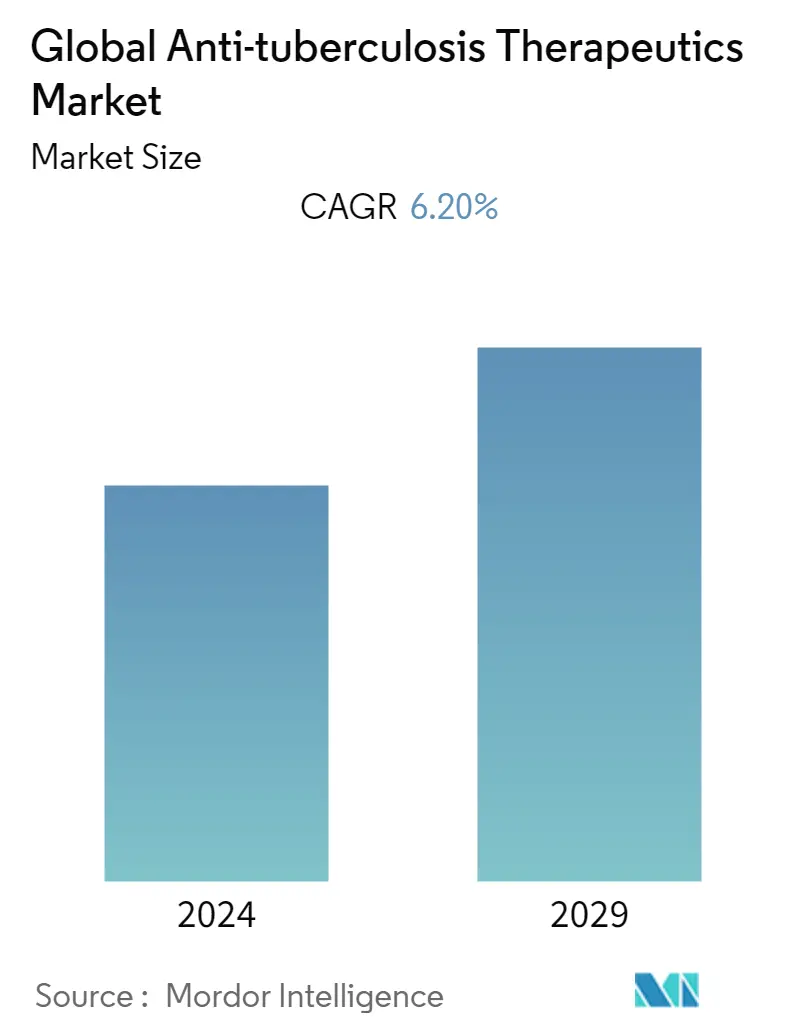Market Size of Global Anti-tuberculosis Therapeutics Industry

| Study Period | 2019 - 2029 |
| Base Year For Estimation | 2023 |
| Forecast Data Period | 2024 - 2029 |
| CAGR | 6.20 % |
| Fastest Growing Market | Asia Pacific |
| Largest Market | North America |
Major Players
*Disclaimer: Major Players sorted in no particular order |
Need a report that reflects how COVID-19 has impacted this market and its growth?
Anti-tuberculosis Therapeutics Market Analysis
The Anti-tuberculosis (TB) Therapeutics Market is expected to witness a CAGR of 6.2% during the forecast period (2022 - 2027).
The COVID-19 pandemic had a significant impact on the healthcare systems, with significant consequences not only for COVID-19-infected patients but also for others, resulting in the cancellation of diagnosis and treatment services to manage and reserve resources, and many hospitals are experiencing a shortage of professionals to assist with these diagnostic and treatment procedures. The COVID-19 restrictions imposed by the government have impacted the market growth. For instance, according to the data published by the World Health Organization, in March 2021, titled 'Impact of the COVID-19 pandemic on TB detection and mortality in 2020', it has been observed that an estimated 1.4 million fewer persons underwent TB treatment in 2020 than in 2019, a 21% decrease from 2019. Additionally, as per an article published by the International Journal of Tuberculosis and Lung Disease, in June 2021, titled 'The impact of COVID-19 on TB: a review of the data, it has been observed that the provision of tuberculosis services has been hampered with high TB burden due to inadequate capacity and equipment, restrictions on migration (affecting health care staff, supplies, and stock), and resource reallocation. Also, tuberculosis patients have struggled to get TB services, either due to fear of SARS-CoV-2 infection, fear of stigma, mobility restrictions, shortened health facility operating hours, or reduced financial resources to pay for care or transportation. As a result, TB diagnosis, treatment, and prevention have been impacted globally. Thus, COVID-19 has significantly impacted the market growth during the pandemic.
Certain factors that are propelling the market growth are the rising prevalence of tuberculosis, a growing initiative from government organizations for tuberculosis awareness, and the rising incidence of multi-drug resistant (MDR) and extensively drug-resistant tuberculosis (XDR) cases in developing countries.
The COVID-19 pandemic had a significant impact on the healthcare systems, with significant consequences not only for COVID-19-infected patients but also for others, resulting in the cancellation of diagnosis and treatment services to manage and reserve resources, and many hospitals are experiencing a shortage of professionals to assist with these diagnostic and treatment procedures. The COVID-19 restrictions imposed by the government have impacted the market growth. For instance, according to the data published by the World Health Organization, in March 2021, titled 'Impact of the COVID-19 pandemic on TB detection and mortality in 2020', it has been observed that an estimated 1.4 million fewer persons underwent TB treatment in 2020 than in 2019, a 21% decrease from 2019. Additionally, as per an article published by the International Journal of Tuberculosis and Lung Disease, in June 2021, titled 'The impact of COVID-19 on TB: a review of the d, it has been observed that the provision of tuberculosis services has been hampered with high TB burden due to inadequate capacity and equipment, restrictions on migration (affecting health care staff, supplies, and stock), and resource reallocation. Also, tuberculosis patients have struggled to get TB services, either due to fear of SARS-CoV-2 infection, fear of stigma, mobility restrictions, shortened health facility operating hours, or reduced financial resources to pay for care or transportation. As a result, TB diagnosis, treatment, and prevention have been impacted globally. Thus, COVID-19 has negatively impacted the market growth during the pandemic.
Additionally, the rising incidence of multi-drug resistant tuberculosis (MDR-TB) and XDR in developing countries is also expected to boost market growth over the forecast period. For instance, according to an article published by the Journal of Family Medicine and Primary Care, in January 2022, titled 'Status of drug-resistant tuberculosis among patients attending a tuberculosis unit of West Bengal', it has been observed that the prevalence of tuberculosis and multidrug-resistant tuberculosis (MDR-TB) is highest in India and ranks first in the global ranking of detecting new cases each year. In addition, as per the same source, an estimated overall incidence of tuberculosis in India was 193 per lakh people, in 2020.
Furthermore, the growing government initiatives in creating awareness among the population regarding tuberculosis (TB) are also expected to propel market growth over the forecast period. For instance, in March 2021, Dr. Harsh Vardhan, Union Minister for Health and Family Welfare launched the 'Tribal TB Initiative' along with Shri Arjun Munda, Union Minister for Tribal Affairs in the presence of Shri Ashwini Kumar Choubey, Minister of State for Health and Family Welfare in India. Also, in July 2019, the State Council of China released the Healthy China Initiative 2019-2030, which included 15 special campaigns, including the Tuberculosis Control Action to guide the way for China's TB prevention and control. Hnece, these factors are expected to boost the market growth.
However, the adverse side effects of anti-tuberculosis drugs and the high cost of MDR and XDR TB drugs are likely to impede the market growth over the forecast period.
